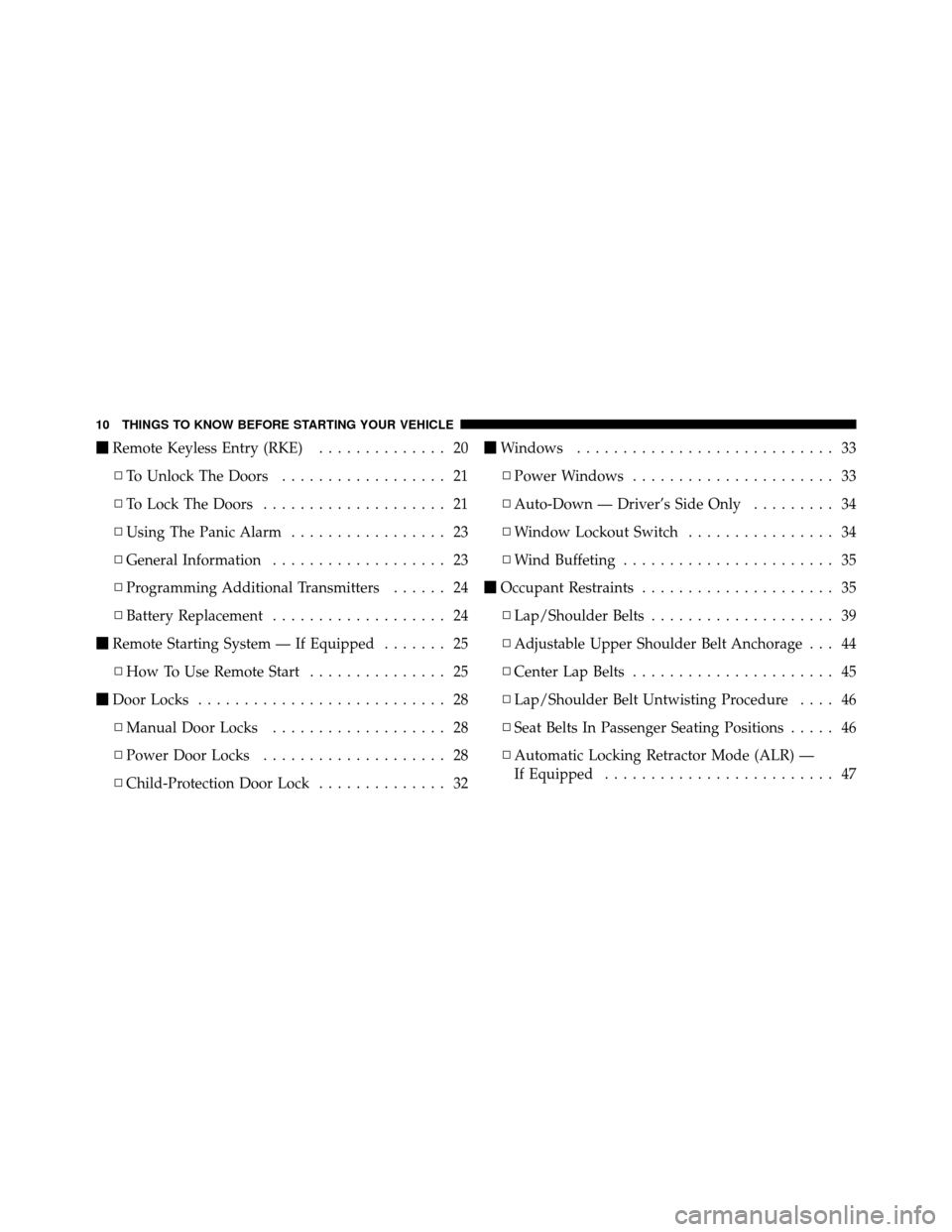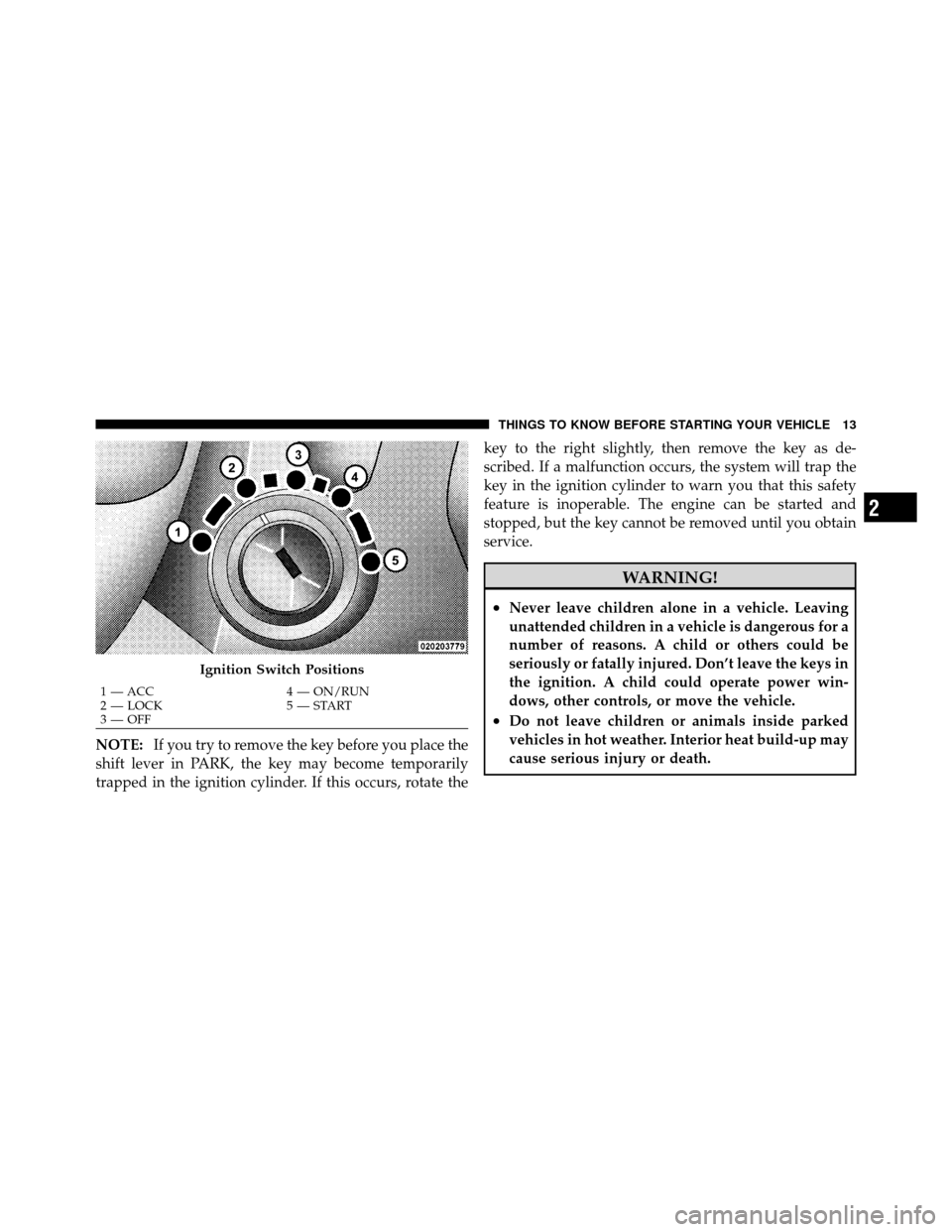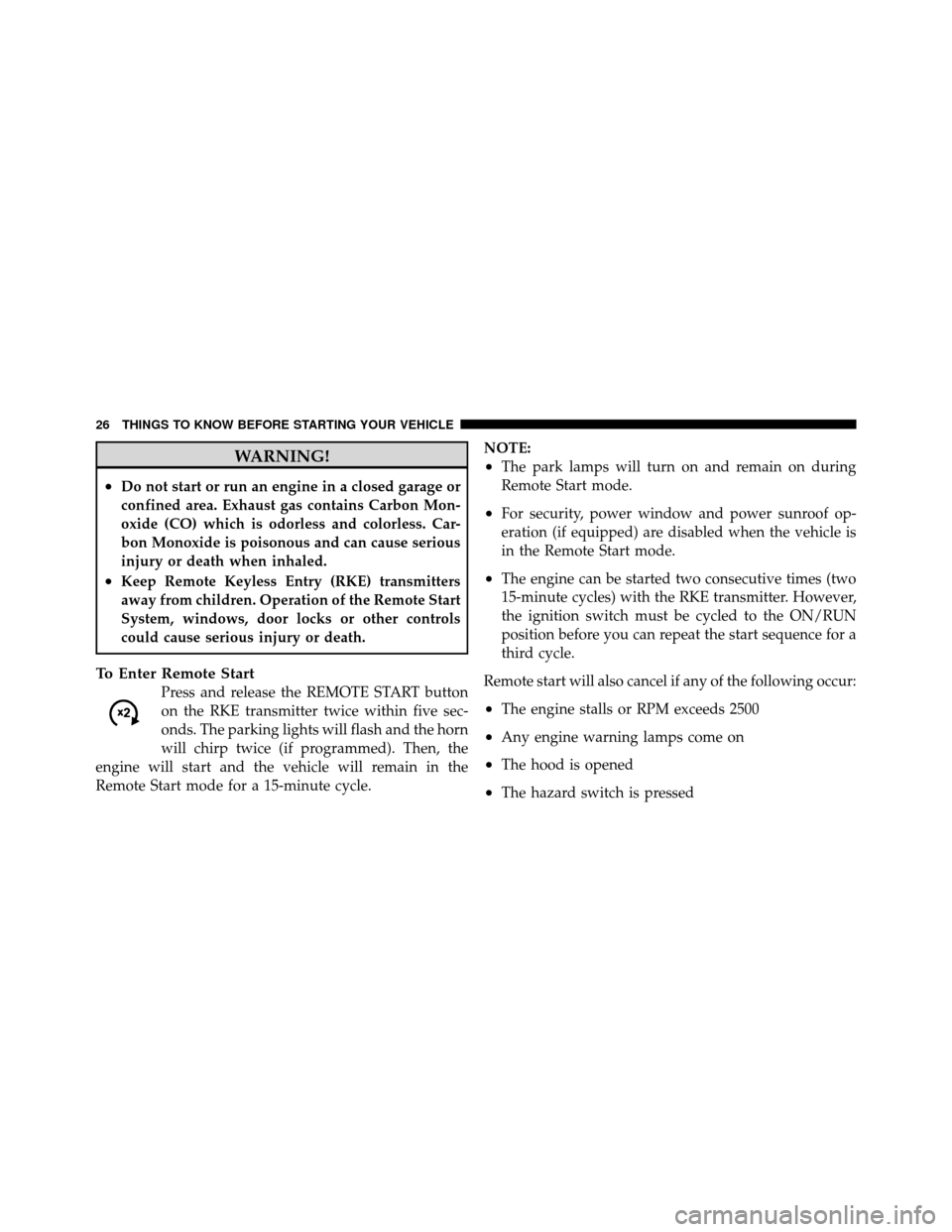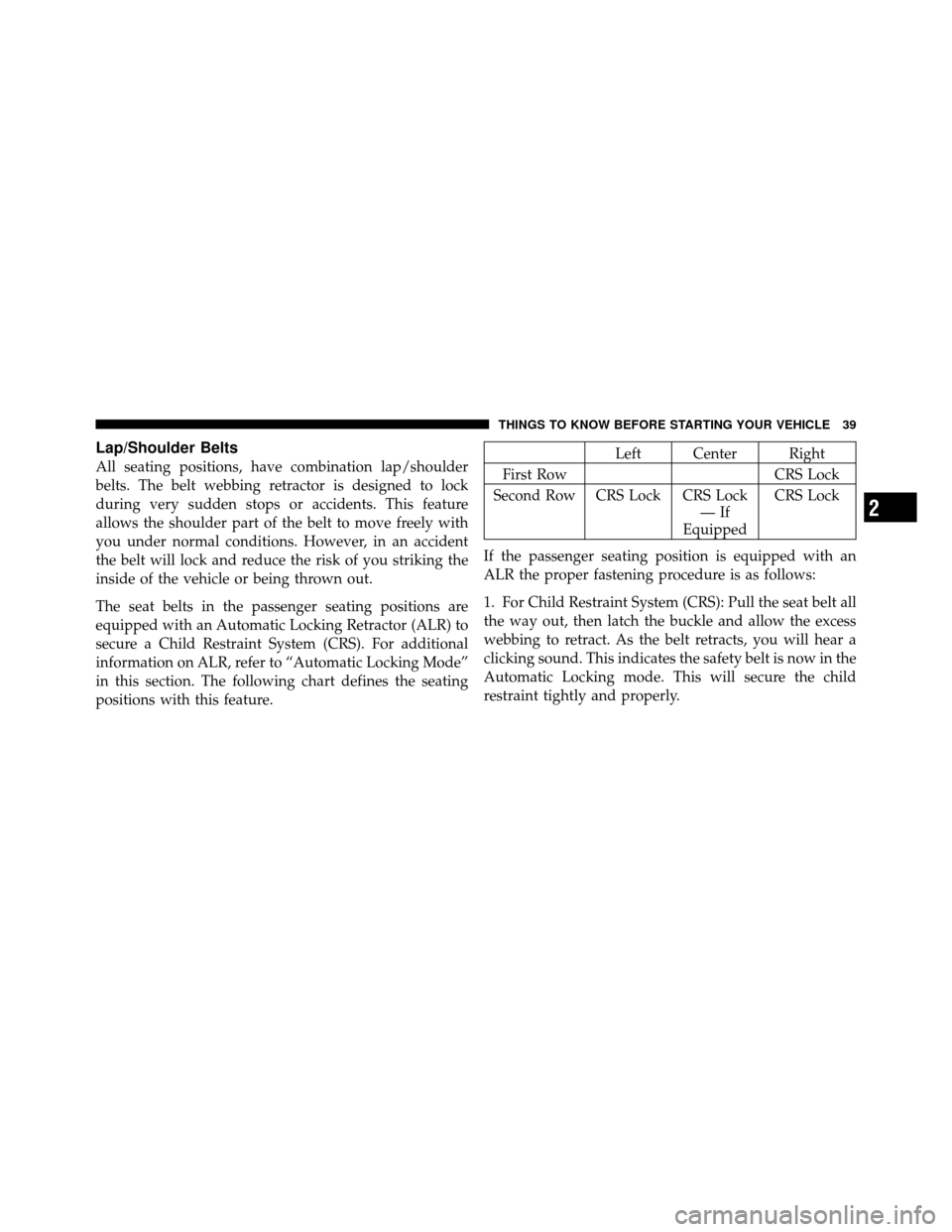Page 12 of 452

�Remote Keyless Entry (RKE) .............. 20
▫ To Unlock The Doors .................. 21
▫ To Lock The Doors .................... 21
▫ Using The Panic Alarm ................. 23
▫ General Information ................... 23
▫ Programming Additional Transmitters ...... 24
▫ Battery Replacement ................... 24
� Remote Starting System — If Equipped ....... 25
▫ How To Use Remote Start ............... 25
� Door Locks ........................... 28
▫ Manual Door Locks ................... 28
▫ Power Door Locks .................... 28
▫ Child-Protection Door Lock .............. 32�
Windows ............................ 33
▫ Power Windows ...................... 33
▫ Auto-Down — Driver’s Side Only ......... 34
▫ Window Lockout Switch ................ 34
▫ Wind Buffeting ....................... 35
� Occupant Restraints ..................... 35
▫ Lap/Shoulder Belts .................... 39
▫ Adjustable Upper Shoulder Belt Anchorage . . . 44
▫ Center Lap Belts ...................... 45
▫ Lap/Shoulder Belt Untwisting Procedure .... 46
▫ Seat Belts In Passenger Seating Positions ..... 46
▫ Automatic Locking Retractor Mode (ALR) —
If Equipped ......................... 47
10 THINGS TO KNOW BEFORE STARTING YOUR VEHICLE
Page 15 of 452

NOTE:If you try to remove the key before you place the
shift lever in PARK, the key may become temporarily
trapped in the ignition cylinder. If this occurs, rotate the key to the right slightly, then remove the key as de-
scribed. If a malfunction occurs, the system will trap the
key in the ignition cylinder to warn you that this safety
feature is inoperable. The engine can be started and
stopped, but the key cannot be removed until you obtain
service.
WARNING!
•Never leave children alone in a vehicle. Leaving
unattended children in a vehicle is dangerous for a
number of reasons. A child or others could be
seriously or fatally injured. Don’t leave the keys in
the ignition. A child could operate power win-
dows, other controls, or move the vehicle.
•Do not leave children or animals inside parked
vehicles in hot weather. Interior heat build-up may
cause serious injury or death.
Ignition Switch Positions
1 — ACC
4 — ON/RUN
2 — LOCK 5 — START
3 — OFF
2
THINGS TO KNOW BEFORE STARTING YOUR VEHICLE 13
Page 28 of 452

WARNING!
•Do not start or run an engine in a closed garage or
confined area. Exhaust gas contains Carbon Mon-
oxide (CO) which is odorless and colorless. Car-
bon Monoxide is poisonous and can cause serious
injury or death when inhaled.
•Keep Remote Keyless Entry (RKE) transmitters
away from children. Operation of the Remote Start
System, windows, door locks or other controls
could cause serious injury or death.
To Enter Remote Start
Press and release the REMOTE START button
on the RKE transmitter twice within five sec-
onds. The parking lights will flash and the horn
will chirp twice (if programmed). Then, the
engine will start and the vehicle will remain in the
Remote Start mode for a 15-minute cycle. NOTE:
•The park lamps will turn on and remain on during
Remote Start mode.
•For security, power window and power sunroof op-
eration (if equipped) are disabled when the vehicle is
in the Remote Start mode.
•The engine can be started two consecutive times (two
15-minute cycles) with the RKE transmitter. However,
the ignition switch must be cycled to the ON/RUN
position before you can repeat the start sequence for a
third cycle.
Remote start will also cancel if any of the following occur:
•The engine stalls or RPM exceeds 2500
•Any engine warning lamps come on
•The hood is opened
•The hazard switch is pressed
26 THINGS TO KNOW BEFORE STARTING YOUR VEHICLE
Page 30 of 452
DOOR LOCKS
Manual Door Locks
All the doors can be manually locked from the inside by
pushing down the door lock knob, located on the door trim
panel. Both front doors may be opened from the inside
with the door lock knob in the down or locked position.
WARNING!
•For personal security and safety in the event of an
accident, lock the vehicle doors as you drive, as
well as when you park and leave the vehicle.
•Never leave children alone in a vehicle. Leaving
unattended children in a vehicle is dangerous for a
number of reasons. A child or others could be
seriously or fatally injured. Don’t leave the key in
the ignition. A child could operate power win-
dows, other controls, or move the vehicle.
Power Door Locks
A power door lock switch is on each front door trim
panel. Use this switch to lock or unlock the doors.
Manual Door Lock Knob
28 THINGS TO KNOW BEFORE STARTING YOUR VEHICLE
Page 34 of 452
Child-Protection Door Lock
To provide a safer environment for children riding in the
rear seat, the rear doors of your vehicle have the child-
protection door lock system.To use the system, open each rear door, slide the lever up
to engage the locks, and down to disengage the child-
protection locks. When the system on a door is engaged,
that door can only be opened by using the outside door
handle, even if the inside door lock is in the unlocked
position.
Child-Protection Door Lock Location
Child Lock Control
32 THINGS TO KNOW BEFORE STARTING YOUR VEHICLE
Page 35 of 452
WARNING!
Avoid trapping anyone in a vehicle in a collision.
Remember that the rear doors can only be opened
from the outside when the Child-Protection locks are
engaged.
NOTE:
•After setting the Child-Protection Door Lock system,
always test the door from the inside to make certain it
is in the desired position.
•For emergency exit with the system engaged, move
the door lock switch to the UNLOCK position, roll
down the window and open the door with the outside
door handle.
WINDOWS
Power Windows
The control on the left front door has up-down switches
that give you finger-tip control of all the power windows. There is a single opening and closing switch on the
passenger doors for passenger window control. The
windows will operate when the ignition switch is turned
to the ON/RUN or ACC position, and for ten minutes
after the ignition is turned OFF unless the driver’s door is
opened.Power Window Switch
2
THINGS TO KNOW BEFORE STARTING YOUR VEHICLE 33
Page 36 of 452
WARNING!
Never leave children alone in a vehicle. Leaving
unattended children in a vehicle is dangerous for a
number of reasons. A child or others could be seri-
ously or fatally injured. Don’t leave the key in the
ignition. A child could operate power windows,
other controls, or move the vehicle.
Auto-Down — Driver’s Side Only
The driver’s window switch has an Auto-Down feature.
Push the window switch past the first detent, release, and
the window will go down automatically. To cancel the
Auto-Down movement, operate the switch in either the
up or down direction and release the switch.
Window Lockout Switch
The Window Lockout Switch on the driver’s door allows
you to disable the window control on the other doors. To
disable the window controls on the other doors, press the
Window Lockout button. To enable the window controls,
press the Window Lockout button a second time.
Power Window Lockout Switch
34 THINGS TO KNOW BEFORE STARTING YOUR VEHICLE
Page 41 of 452

Lap/Shoulder Belts
All seating positions, have combination lap/shoulder
belts. The belt webbing retractor is designed to lock
during very sudden stops or accidents. This feature
allows the shoulder part of the belt to move freely with
you under normal conditions. However, in an accident
the belt will lock and reduce the risk of you striking the
inside of the vehicle or being thrown out.
The seat belts in the passenger seating positions are
equipped with an Automatic Locking Retractor (ALR) to
secure a Child Restraint System (CRS). For additional
information on ALR, refer to “Automatic Locking Mode”
in this section. The following chart defines the seating
positions with this feature.Left Center Right
First Row CRS Lock
Second Row CRS Lock CRS Lock —If
Equipped CRS Lock
If the passenger seating position is equipped with an
ALR the proper fastening procedure is as follows:
1. For Child Restraint System (CRS): Pull the seat belt all
the way out, then latch the buckle and allow the excess
webbing to retract. As the belt retracts, you will hear a
clicking sound. This indicates the safety belt is now in the
Automatic Locking mode. This will secure the child
restraint tightly and properly.
2
THINGS TO KNOW BEFORE STARTING YOUR VEHICLE 39